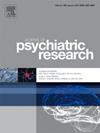Effect of combined Tai Chi and repetitive transcranial magnetic stimulation for sleep disturbance in older adults: A randomized controlled trial
IF 3.7
2区 医学
Q1 PSYCHIATRY
引用次数: 0
Abstract
Background and aims
Novel approaches to improve sleep disturbance in older adults are needed. Our study comprises a pioneering attempt to test the efficacy of Tai Chi (TC) combined with repetitive transcranial magnetic stimulation (rTMS) in improving sleep disturbance in older adults. The influence of baseline depressive symptoms was tested in a subset of the sample.
Method
In the randomized controlled trial, 152 participants were each allocated to one of the following groups: (1) TC plus active rTMS (n = 38), (2) TC plus sham rTMS (n = 38), (3) TC alone (n = 38), and (4) low-intensity physical exercise (PE) control group (n = 38). Four-week interventions were conducted for each group. The outcomes included insomnia severity, actigraphy-assessed and self-reported sleep parameters, mood states, and quality of life. Assessments were carried out at baseline (T0), post-intervention (T1), and 3-month follow-up (T2).
Results
Of the 152 randomized participants, the mean (SD) age was 67.68 (4.98) years, with 112 female (73.68%). The findings revealed that TC plus active rTMS induced a significant reduction in actigraphy-assessed sleep onset latency compared to TC plus sham rTMS at T1 and T2. In the subsample without depressive symptoms, the combination treatment exhibited a greater benefit in actigraphy-assessed sleep efficiency and wake time after sleep onset compared to both variables in the PE group and in the sham comparator group at T1, respectively. The other subsample with depressive symptoms showed the improvements with TC plus active rTMS, TC plus sham rTMS, and TC alone differed significantly from PE at T1 and T2.
Conclusions
This study has demonstrated the positive effect of TC combined with rTMS on sleep disturbance in older adults. Specific sample characteristics should be considered when applying TC, either alone or combined with rTMS.
太极拳与重复经颅磁刺激相结合对老年人睡眠障碍的影响:随机对照试验
背景和目的:改善老年人睡眠障碍需要新的方法。我们的研究是一项开创性的尝试,旨在测试太极拳(TC)与重复经颅磁刺激(rTMS)相结合对改善老年人睡眠障碍的疗效。我们还在部分样本中测试了基线抑郁症状的影响:在随机对照试验中,152 名参与者被分配到以下几组中的一组:(1)经颅磁刺激加主动经颅磁刺激组(38 人);(2)经颅磁刺激加假经颅磁刺激组(38 人);(3)单独经颅磁刺激组(38 人);(4)低强度体育锻炼(PE)对照组(38 人)。每组进行为期四周的干预。研究结果包括失眠严重程度、动图评估和自我报告的睡眠参数、情绪状态和生活质量。评估分别在基线(T0)、干预后(T1)和 3 个月随访(T2)时进行:在 152 名随机参与者中,平均(标清)年龄为 67.68(4.98)岁,女性 112 人(73.68%)。研究结果显示,与TC加假经颅磁刺激相比,在T1和T2阶段,TC加活性经颅磁刺激能显著降低动觉测定的睡眠开始潜伏期。在无抑郁症状的子样本中,联合疗法分别在T1的动觉计评估睡眠效率和睡眠开始后的唤醒时间方面比PE组和假参照组的两个变量都有更大的优势。另一个有抑郁症状的子样本显示,在T1和T2,TC加活性经颅磁刺激、TC加假经颅磁刺激和单独使用TC的改善效果与PE有显著差异:本研究证明了经颅磁刺激联合经颅磁刺激对老年人睡眠障碍的积极影响。在单独应用TC或与经颅磁刺激联合应用时,应考虑特定的样本特征。
本文章由计算机程序翻译,如有差异,请以英文原文为准。
求助全文
约1分钟内获得全文
求助全文
来源期刊

Journal of psychiatric research
医学-精神病学
CiteScore
7.30
自引率
2.10%
发文量
622
审稿时长
130 days
期刊介绍:
Founded in 1961 to report on the latest work in psychiatry and cognate disciplines, the Journal of Psychiatric Research is dedicated to innovative and timely studies of four important areas of research:
(1) clinical studies of all disciplines relating to psychiatric illness, as well as normal human behaviour, including biochemical, physiological, genetic, environmental, social, psychological and epidemiological factors;
(2) basic studies pertaining to psychiatry in such fields as neuropsychopharmacology, neuroendocrinology, electrophysiology, genetics, experimental psychology and epidemiology;
(3) the growing application of clinical laboratory techniques in psychiatry, including imagery and spectroscopy of the brain, molecular biology and computer sciences;
 求助内容:
求助内容: 应助结果提醒方式:
应助结果提醒方式:


